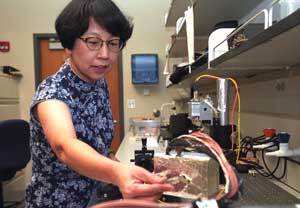It’s the Chinese year of the dog as of Jan. 29, and the Mars Exploration Rover (MER) mission team is naming features on the Red Planet for Chinese mythological characters.
The rover Spirit is driving toward a feature called “Home Plate,” and plans to be there shortly after the Chinese New Year.

It’s common for NASA to name features on planets and stars in constellations for characters in Greek mythology, or in honor of esteemed NASA colleagues.
For instance, last October the Athena team named a prominent ridge on the east side of Husband Hill’s summit in the Columbia Hills of Gusev crater “Haskin Ridge,” in honor and memory of Larry A. Haskin, Ph.D., the Ralph E. Morrow Distinguished University Professor of Earth and Planetary Sciences in Arts & Sciences.
The high point in the Columbia Hills is “Husband Hill,” named after the late Rick Husband, commander of the shuttle Columbia. And six other hills in Gusev crater are named after the six other astronauts who flew on Columbia’s last mission.
Alian Wang, Ph.D., WUSTL senior research scientist in earth and planetary sciences, and fellow Athena science and engineering team member Ron Li, Ph.D., of Ohio State University made a proposal to Steven Squyres, Ph.D., and Raymond E. Arvidson, Ph.D.
Squyres — who will speak for the Assembly Series at 11 a.m. Feb. 8 in Graham Chapel — is professor of astronomy at Cornell University and principal investigator of the Athena Science payload on the MER. Arvidson is the James S. McDonnell Distinguished University Professor and chair of earth and planetary sciences at WUSTL and MER deputy principal investigator.
Both Wang and Li have a Chinese cultural background. Wang was born in Beijing; she came to the United States and began working at WUSTL in 1993.
According to Wang, Native American themes have been used at several locations on the MER mission, as have names related to the Fourth of July, Thanksgiving, France’s Bastille Day, German Unification Day and others.
“Ron and I have discussed a potential Chinese naming campaign, and we decided the Chinese New Year is the best time to do it,” Wang said.
In December, Wang visited China, invited by the president of Shandong University (SDU), a sister university of Washington University. The president, Zhan Tao, had visited WUSTL and Chancellor Mark S. Wrighton last May and saw the Mars rover replica in the Earth and Planetary Sciences Building.
“The students at Shandong University were very much excited by the Mars rover project,” Wang said. “They also suggested some Chinese terms for this naming campaign.
“Therefore, from Ron, me, Ron’s students and Chinese students from two universities — SDU and Peking University — we made a list of Chinese myths and characters, some of them real, such as Yao, Shun and DaYu, the first three great emperors in the beginning of Chinese history. Some of them will be used to name the features at Gusev starting this week.”
Wang said the Chinese media are extremely interested in this phase of the MER mission, which in addition to being one of the most productive of NASA’s planetary missions, has been fun for both the MER science and engineering team and the public.
In the coming days and weeks, the next rise in Spirit’s path could be named SuiRen, inventor of fire usage on Earth, who stole a seed of fire from the heavens and gave it to mankind; or PanGu, the first god who created the universe; or first goddess NuWa, who repaired the broken sky using melted colorful stones and also created mankind on Earth; or KuaFu, a giant who challenged the sun by chasing it, dying in his efforts; or the warrior Xing Tian, who, despite having his head cut off by his enemies, still managed to fight them.
The characters are abundant, but the team is not limited to people or myths. Real-life rivers and lakes are possibilities, as are mountains and mountain peaks, and famous places such as the Great Wall and the Silk Road.
“Naming parts of Mars to reflect your cultural background makes the excitement of discovery all the more appealing,” Wang said.
Besides Arvidson and the late Haskin, Wang’s other colleagues on the Athena team are Bradley L. Jolliff, Ph.D., research associate professor in earth and planetary sciences, and Ed Guinness, Ph.D., senior research scientist in earth and planetary sciences.